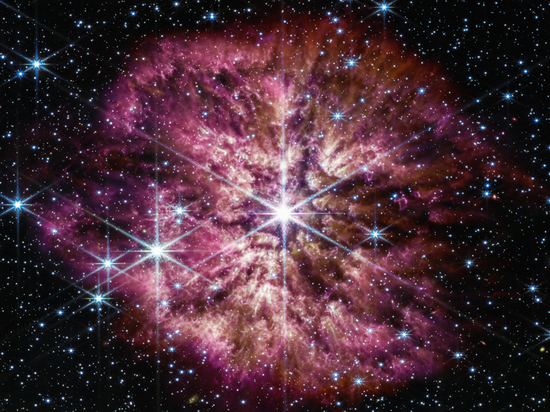Scientists: 'We've never seen anything like this before'
The James Webb Space Telescope has captured a rare image of a dying star. Scientists have published an image of a star in the constellation Sagittarius on the verge of becoming a supernova. The infrared lens of the telescope observed the gas and dust thrown into space by a huge star located at a distance of 15 thousand light years.

The James Webb Space Telescope captured a rare and fleeting phase of a star at death's door.
According to The Guardian, this observation was one of the first made by the telescope after its launch in late 2021, but the image was published only this week. Infrared «eyes» telescopes observed all the gas and dust thrown into space by a huge hot star located at a distance of 15 thousand light years. A light year is about 5.8 trillion miles.
Shimmering purple like a cherry blossom, the ejected material once made up the star's outer layer. Hubble Space Telescope took a picture of the same passing star decades ago, but it looked more like a fireball without fine details.
According to scientists, this transformation occurs only with some stars and is usually the last step before they explode, turning into a supernova.
“We have never seen anything like this before. It's really exciting”,– notes project participant Macarena Garcia Marin from the European Space Agency.
Officially known as WR 124 (Wolff-Rayet 124), this star in the constellation Sagitta, officially known as WR 124 (Wolff-Rayet 124), is thirty times the size of our Sun and has already ejected enough material to form 10 suns, according to NASA.
A new photo has been released at the South by Southwest conference in Austin, Texas, writes The Guardian.
«What we see in this beautiful new image at the very center is – this is a star, – comments Amber Straun from NASA. – The light from this star traveled in space for about 15,000 years, it is 15,000 light years away, until it hit the telescope's detectors. And the stuff you see around the central star that looks like dust is – is dust. And so, at the end of their lives, stars shed their outer material, their outer layers, into the rest of the universe.»
She added, «I think this is one of the most beautiful concepts in all of astronomy. This is the concept of «Stardust» Carl Sagan. The fact that the iron in your blood and the calcium in your bones were literally forged inside a star that exploded billions of years ago. And that's what we see in this new image. This dust spreads through space and will eventually create planets. And that's how we got here really".

